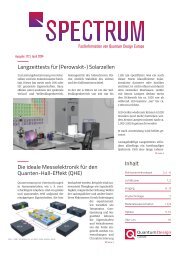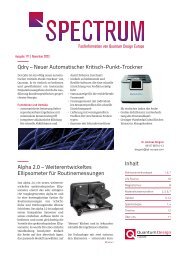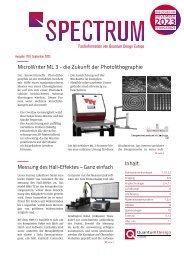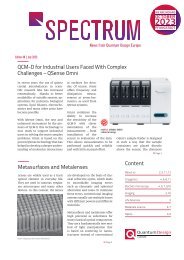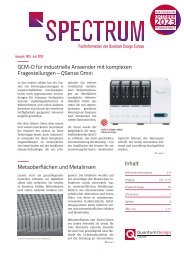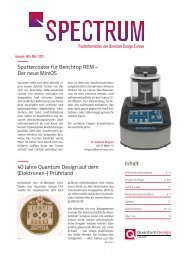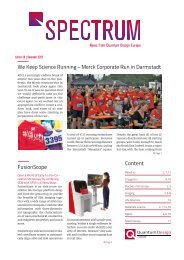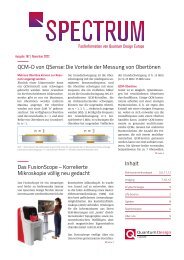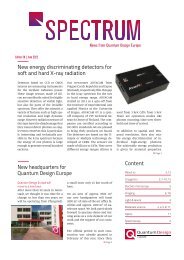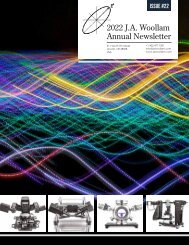Lake Shore Cryotronics probe stations catalogue
You also want an ePaper? Increase the reach of your titles
YUMPU automatically turns print PDFs into web optimized ePapers that Google loves.
Probe <strong>stations</strong><br />
Probe <strong>stations</strong><br />
Applications overview<br />
<strong>Lake</strong> <strong>Shore</strong> <strong>probe</strong> <strong>stations</strong> are well suited for a broad range of material characterization and measurement applications.<br />
The table below lists several of these applications and indicates where each <strong>probe</strong> station is a good fit (orange) or has<br />
been specifically designed for this purpose (star).<br />
I-V<br />
C-V<br />
Cryogenic <strong>probe</strong> <strong>stations</strong><br />
Cryogen-free <strong>probe</strong> <strong>stations</strong><br />
TTPX CPX CPX-VF EMPX-H2 FWPX CRX-6.5K CRX-4K CRX-VF CRX-EM-HF<br />
Microwave <br />
Electro-optical <br />
Magneto-transport (MT) <br />
Vector dependent MT <br />
Hall effect measurement<br />
** ** ** ** **<br />
Organics <br />
Controlled sample transport <br />
Large wafer*<br />
<br />
Research examples<br />
Superconducting RF MEMS filter design<br />
A novel superconducting RF MEMS switch<br />
is implemented in a capacitor bank to realize<br />
different capacitance values. The capacitor bank<br />
is monolithically integrated to a shunt bandstop<br />
resonator. Figure 1 shows the circuit model of<br />
the tunable resonator. The resonator consists of<br />
a lumped element spiral inductor in series with<br />
a switched capacitor bank. Figure 2 illustrates a<br />
picture of the monolithically integrated bandstop<br />
resonator with the capacitor bank. The dimension<br />
of the device is 2.7 mm × 1.3 mm, which is<br />
extremely miniaturized for a high quality factor<br />
tunable resonator. The tunable resonator is<br />
measured in the <strong>Lake</strong> <strong>Shore</strong> cryogenic <strong>probe</strong><br />
station using two ground-signal-ground (GSG)<br />
<strong>probe</strong>s. Figure 3 shows the measured results of<br />
the three states of the tunable resonator at 4 K.<br />
The resonance frequency is initially at 1.107 GHz<br />
when all the switches are off (state I); then shifts<br />
to 1.057 GHz and 1.025 GHz when the first and<br />
the second switches are on, respectively.<br />
Raafat R. Mansour, Ph.D, Professor<br />
Electrical and Computer Engineering Department<br />
University of Waterloo<br />
Figure 2<br />
Figure 1<br />
Figure 3<br />
= Recommended for = Is capable of<br />
* For probing wafers larger than 102 mm or 152 mm, contact <strong>Lake</strong> <strong>Shore</strong><br />
** Limited Hall effect measurements possible with 0.2 T ring magnet installed<br />
Applications<br />
Nanoelectronics<br />
Magnetism & spintronics<br />
Organic & molecular electronics<br />
Semiconductors<br />
Optoelectronics<br />
Microwave electronics<br />
Quantum devices<br />
Superconductors<br />
MEMS/NEMS<br />
Low noise RF<br />
Ferrolectrics<br />
Thin films<br />
IR detectors<br />
DLTS/DLOS to measure defects in semiconductor devices<br />
Deep level transient spectroscopy (DLTS) is a powerful<br />
technique to measure defects in semiconductors and<br />
interfaces in a variety of devices. For wide bandgap-based<br />
devices, deep level optical spectroscopy (DLOS) enables<br />
probing deeper than the thermal limit of ~1 eV and probing<br />
of traps in the minority carrier half of the bandgap. These<br />
techniques are traditionally performed on Schottky or<br />
p-n junctions, but can also be applied to metal-insulatorsemiconductor<br />
capacitors (MISCaps) to accurately quantify<br />
interface state densities throughout the interface bandgap.<br />
Figure 1 shows a typical structure for measuring interface<br />
states and Fig. 2 shows the results of the thermal and<br />
optical DLTS/DLOS scans of the sample in Fig. 1. The<br />
interface states are shown directly correlate with frequency<br />
dispersion and can cause a number of performance related<br />
issues (leakage pathways, transient threshold voltage shifts,<br />
noise, etc.) in typical devices.<br />
The <strong>Lake</strong> <strong>Shore</strong> cryogenic stages allow scanning the<br />
temperature over a wide range, ideal for DLTS, and provides<br />
easy optical access to shine monochromatic light on the<br />
samples for DLOS. Customized for our application, the<br />
<strong>probe</strong>s allow scanning hundreds of degrees Kelvin without<br />
contacts slipping and without destroying delicate contacts<br />
(something not possible in many cryogenic stages).<br />
Aaron Arehart, Ph.D, Professor<br />
Electrical and Computer Engineering Department<br />
The Ohio State University<br />
Figure 1: Metal-insulator-semiconductor<br />
structure for analyzing interface state<br />
densities at the insulator-semiconductor<br />
interface, specifically the atomic layer<br />
deposition (ALD)-grown Al 2 O 3 /n-type<br />
NH 3 -MBE-grown GaN interface is<br />
quantified using deep level transient and<br />
optical spectroscopies (DLTS/DLOS).<br />
Figure 2: Interface state<br />
density (D it ) at the ALD Al 2 O 3 /<br />
GaN interface in Figure 1 is<br />
shown using thermally-based<br />
DLTS for states within 0.8 eV<br />
of the GaN conduction band<br />
and optically stimulated<br />
emission-based DLOS using a<br />
xenon (Xe) lamp for mid-gap<br />
to GaN valence band.<br />
p. 6<br />
<strong>Lake</strong> <strong>Shore</strong> <strong>Cryotronics</strong>, Inc. | t. 614.891.2243 | f. 614.818.1600 | info@lakeshore.com | www.lakeshore.com<br />
p. 7<br />
<strong>Lake</strong> <strong>Shore</strong> <strong>Cryotronics</strong>, Inc. | t. 614.891.2243 | f. 614.818.1600 | info@lakeshore.com | www.lakeshore.com<br />
Quantum Design GmbH Matthias Müller: +49 6151 8806-554, mueller@qd-europe.com<br />
Im Tiefen See 58<br />
David Appel: +49 6151 8806-499, appel@qd-europe.com<br />
6 D-64293 Darmstadt Find your local contact at www.qd-europe.com<br />
7<br />
Quantum Design GmbH<br />
Im Tiefen See 58<br />
D-64293 Darmstadt<br />
Matthias Müller: +49 6151 8806-554, mueller@qd-europe.com<br />
David Appel: +49 6151 8806-499, appel@qd-europe.com<br />
Find your local contact at www.qd-europe.com



